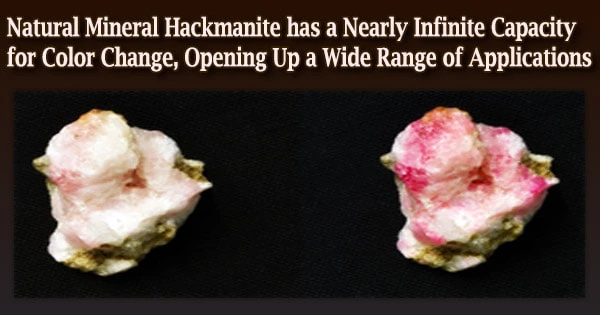Researchers studying the natural wonder material hackmanite discovered that it, along with two other minerals, can alter its color upon repeated exposure to UV radiation without wearing out.
The findings demonstrate that the cheap, easily synthesized hackmanite is also a superior material due to its high durability and adaptability to a variety of uses.
The properties of the wonder substance hackmanite have been studied and developed for almost ten years by a research team at the University of Turku in Finland. X-ray imaging and personal UV monitoring are two examples of applications that have been created using hackmanite’s ability to change color.
Under UV exposure, hackmanite turns from white to purple and finally returns to its original color of white if UV is not present. It has not yet been determined what structural characteristics allow for such frequent modifications. The researchers have now discovered the solution after looking into three natural minerals: hackmanite, tugtupite, and scapolite.
Although the researched color-changing minerals are inorganic natural substances, there are also organic substances, such as hydrocarbons, that can undergo reversible color changes as a result of radiation exposure.
However, these hydrocarbons can only change color a limited number of times until their molecular structure disintegrates. This is due to the fact that changing hue requires a significant change in structure, and undergoing this shift repeatedly causes the molecule to finally shatter.
“In this research, we found out for the first time that there is actually a structural change involved in the color change process as well. When the color changes, sodium atoms in the structure move relatively far away from their usual places and then return back. This can be called as structural breathing and it does not destroy the structure even if it is repeated a large number of times,” reports Professor Mika Lastusaari from the Department of Chemistry at the University of Turku, Finland.
The strength of hackmanite’s color depends on how much UV radiation it is exposed to, which means that the material can be used, for example, to determine the UV index of Sun’s radiation. The hackmanite that will be tested on the space station will be used in a similar fashion, but this property can also be used in everyday applications. We have for example already developed a mobile phone application for measuring UV radiation that can be used by anyone.
Sami Vuori
Researchers demonstrated that the ability of hackmanite to switch between its white and purple forms is remarkably reproducible.
Professor Lastusaari claims that the strength of these minerals’ overall three-dimensional cage-like structure, which is comparable to that seen in zeolites, is what gives them their endurance. Zeolite can remove calcium and magnesium from water by binding them firmly inside the pores of the cage in detergents, for instance.
“In these color-changing minerals, all processes associated with the color change occur inside the pores of the zeolitic cage where the sodium and chlorine atoms reside. That is, the cage-like structure allows atomic movement inside the cage while keeping the cage itself intact. This is why minerals can change color and revert back to their original color practically indefinitely,” Doctoral Researcher Sami Vuori explains.
Scapolite is known to change color much more quickly than hackmanite, but tugtupite changes color much more slowly.
“Based on the results of this work, we found out that the speed of the color change correlates with the distance that the sodium atoms move. These observations are important for future material development, because now we know what is required from the host structure to allow the control and tailoring of the color change properties,” comments Doctoral Researcher Hannah Byron.
“There were no characterisation methods available for the research on color-changing minerals, which is why we have developed new methods by ourselves. However, it is difficult to interpret the results unambiguously based on experimental data alone. In fact, we could not have reached the present conclusions without strong support from theoretical calculations, since only the combination of experimental and computational data shows the whole picture. We owe a great many thanks to our collaborator Professor Tangui Le Bahers and his group, who have developed and advanced suitable computational methods to such detail and accuracy that would not have been possible just a few years ago,” reflects Lastusaari.
Hackmanite has amazing potential for applications
Under the direction of Lastusaari, the Intelligent Materials Research Group at the Department of Chemistry of the University of Turku has long done groundbreaking studies on substances with light- and color-related properties, particularly hackmanite. Hackmanite has a wide range of potential uses, including the potential replacement of LEDs and other light bulbs with the mineral as well as its use in X-ray imaging.
A hackmanite-based dosimeter and passive detectors for the International Space Station, designed to be used to evaluate the radiation dose intake of materials during space travels, are among the most intriguing directions that the researchers are now pursuing.
“The strength of hackmanite’s color depends on how much UV radiation it is exposed to, which means that the material can be used, for example, to determine the UV index of Sun’s radiation. The hackmanite that will be tested on the space station will be used in a similar fashion, but this property can also be used in everyday applications. We have for example already developed a mobile phone application for measuring UV radiation that can be used by anyone,” explains Sami Vuori.
The University of Turku, Finland’s Intelligent Materials Chemistry research group, the Materials Research Laboratory, the University Claude Bernard Lyon 1, France, and the Mineralogical Society of Antwerp, Belgium made up the worldwide research partnership.





